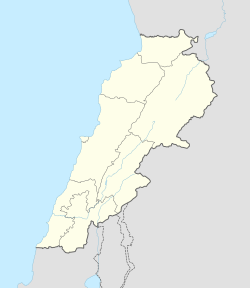Nahle, Lebanon
Today we are going to enter the exciting world of Nahle, Lebanon. Whether you are an expert in the field or just curious to learn more about it, this article will give you a comprehensive overview of everything related to Nahle, Lebanon. From its origins to its relevance today, through its possible applications in various fields, this article seeks to delve into all the relevant aspects that make Nahle, Lebanon a topic worth exploring. Join us on this journey of knowledge and discover everything there is to know about Nahle, Lebanon.
Nahlé | |
|---|---|
Village | |
 | |
| Country | |
| Governorate | Baalbek-Hermel |
| District | Baalbek |
نحله | |
| Location | 6 kilometres (3.7 mi) northeast of Baalbek |
|---|---|
| Region | Baalbek |
| Coordinates | 34°03′30″N 36°17′58″E / 34.05833°N 36.29944°E |
| History | |
| Cultures | Roman |
| Site notes | |
| Condition | Ruins |
| Public access | Yes |
Nahlé (Arabic: نحله Nahlah), is a village situated 6 kilometres (3.7 mi) northeast of Baalbek in Baalbek District, Baalbek-Hermel Governorate, Lebanon.[1] It has the ruins of a Roman temple.
Name
The Lebanese town of Nahlé derives its name from the Arabic word “نحلة” (Nahleh), meaning “honeybee.” This interpretation reflects a connection to nature, potentially emphasizing the industrious and community-oriented qualities associated with bees. Additionally, Nahlé is known for its ancient history, including Roman-era ruins, suggesting that the name could also carry historical or cultural significance tied to its origins.
History
Nahle was probably founded during Roman rule of the region, that was called in the first century Roman Phoenicia.[citation needed]
The 13th-century geographer Yaqut al-Hamawi listed Nahlah in his geographical dictionary, with its entry being "a village lying 3 miles from Ba'labakk".[2]
In 1838, Eli Smith noted Nahleh as a Metawileh village in the Baalbek area.[3] Actually Nahle is located above a valley.[citation needed]
Roman temple
There are the ruins of a Roman temple in the village that are included in a group of Temples of the Beqaa Valley.[4]
The temple foundations are made of gigantic blocks of stone, upon which sit the remains of a podium. The podium has a long inscription written on it that is now almost impossible to read.[1] The huge foundations indicate that there was a huge temple over these foundations during Roman centuries.[5]
This sanctuary consisted of two parts: an open air court and a large room with a ceiling where notches for the wooden beam still exist. Only a few courses of stone are still standing.[citation needed]
During the 2024 Israeli invasion of Lebanon, UNESCO gave enhanced protection to 34 cultural sites in Lebanon including the temple at Nahlé to safeguard it from damage.[6][7]
References
- ^ a b George Taylor (1967). The Roman temples of Lebanon: a pictorial guide. Dar el-Machreq Publishers. Retrieved 27 October 2012.
- ^ Le Strange, Guy (1890). Palestine Under the Moslems. London: A. P. Watt. p. 514. Retrieved 13 February 2022.
- ^ Robinson and Smith, 1841, vol 3, 2nd appendix, p. 145
- ^ Othmar Keel (1997). The Symbolism of the Biblical World: Ancient Near Eastern Iconography and the Book of Psalms. Eisenbrauns. pp. 159–. ISBN 978-1-57506-014-9. Retrieved 27 October 2012.
- ^ Nahle Roman temple
- ^ "Cultural property under enhanced protection Lebanon". Archived from the original on 2024-12-31. Retrieved 2025-01-01.
- ^ "Lebanon: 34 cultural properties placed under enhanced protection". Archived from the original on 2024-12-27. Retrieved 2025-01-01.
Bibliography
External links
- Nahleh, Localiban
- Photo of the Nahle Valley on the website of the American University of Beirut
- Photo of Nahle temple on the website of the American University of Beirut
- Nahle on travelingluck.com
- Nahle on Wikimapia
- Nahle on lebanon.com
- Nahle on middleeast.com
- Picture of Nahle temple foundation stones on alblebanon.com
- Picture of Nahle temple foundation stones on alblebanon.com


